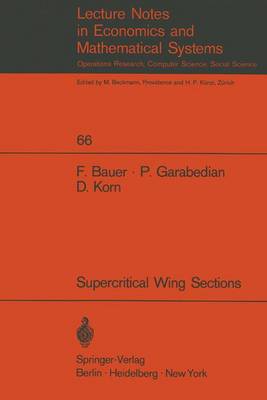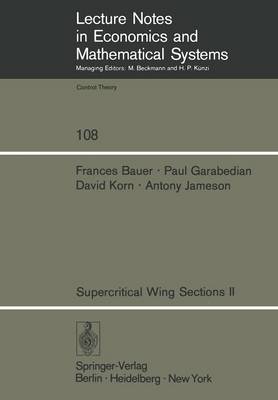Lecture Notes in Economics and Mathematical Systems
3 primary works
Book 66
A Theory of Supercritical Wing Sections, with Computer Programs and Examples
by F. Bauer, P. R. Garabedian, and D. Korn
Published 21 April 1972
At present, there is considerable interest in supercritical wing technology for the development of aircraft designed to fly near the speed of sound. The basic principle is the suppression of boundary layer separation by shifting the shock waves that occur on the wing toward the trailing edge and making them as weak as possible. The purpose of this report is to make available to the engineering public mathematical methods for the design of supercritical wings. These methods depend on the numerical solution of the partial differential equations of two-dimensional gas dynamics. The main contribution is a computer program for the design of shockless transonic airfoils using the hodograph transformation and analytic continuation into the complex domain. Another contribution is a program for the analysis of transonic flow with shocks past an airfoil at off-design conditions. In our design work we include a turbulent boundary layer correction. Part I of the paper is devoted to a description of the mathemati cal theory and need not be studied by those primarily concerned with running the programs. Part II is a manual for users of our programs which is independent of the theoretical part. In Part III and in Appendices II and III we give numerical examples and discuss computa tional results. The main substance of the report, however, is contained in the listing of the computer programs themselves in Appendix IV. We have used the Fortran language throughout and we have included numerous comment cards in the listing.
Book 108
Supercritical Wing Sections II
by F. Bauer, P. R. Garabedian, D. Korn, and A. Jameson
Published 13 February 1975
This handbook is a sequel to an earlier volume entitled "A Theory of Supercritical Wing Sections, with Computer Programs and Examples." Since the completion of the first volume, which we shall refer to as Volume I (cf. [ll), some effort has been made to improve our airfoil design program. A number of more desirable air foils have been designed. In addition several of our wing sections have been tested in wind tunnels. We should like to make this material available here, since it is more convenient to use the design program in conjunction with data for a fairly broad range of examples. Moreover, we have developed new analysis programs that supersede our previous work. Chapter I is devoted to a brief discussion of the mathematics involved in our additions and modifications. There is only a mini mum emphasis on theory, since the representation of important physical phenomena such as boundary layer shock wave interaction and separation is partly empirical. It is our contention, however, that the computer programs provide a better simulation than might have been expected. Chapter II presents numerical results found by our new methods, as well as comparisons with experimental data. Chapter III contains a discussion of the use of the program together with Fortran listings.
Book 150
Supercritical Wing Sections III
by F. Bauer, P. R. Garabedian, and D. Korn
Published 1 December 1977
The purpose of this book is to survey computational flow research on the design and analysis of supercritical wing sections supported by the National Aeronautics and Space Administration at the Energy Research and Development Administration Mathematics and Computing Laboratory of New York University. The work was performed under NASA Grants NGR 33-016-167 and NGR 33-016-201 and ERDA Contract EY-76-C-02-3077. Computer programs to be listed and described have applications in the study of flight of modern aircraft at high sub sonic speeds. One of the codes generates cascades of shockless tran sonic airfoi~s that are expected to increase significantly the effici ency of compressors and turbines. Good simulation of physically observed flows has been achieved. This work is a sequel to two earlier books [1,2] published by Springer-Verlag under similar titles that we shall refer to as Volumes I and II. New York November 1977 TABLE OF CONTENTS I. INTRODUCTION 1 1. Shockless Airfoils and Supercritical Wing Sections 1 2. Differential Equations of Gas Dynamics 2 II. THE METHOD OF COMPLEX CHARACTERISTICS 5 1. A New Boundary Value Problem 5 2. Topology of the Paths of Integration 8 3. Iterative Scheme for the Map Function 9 III. TRANSONIC AIRFOIL DESIGN CODE 10 1. Isolated Airfoils 10 2. Compressor Cascades 12 3. Turbine Cascades 13 4. Comparison with Experiment 14 IV. TWO-DU1ENSIONAL ANALYSIS CODE 16 1. Wave Drag 16 2. A Fast Solver 19 3. Remarks about Three-Dimensional Flow 24 V. REFERENCES 26 VI.


